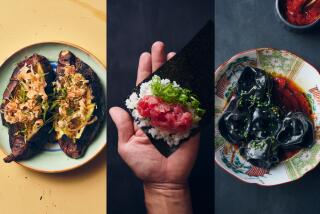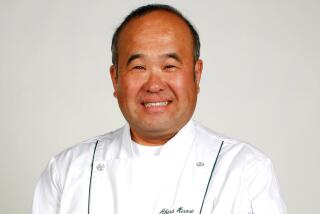TRAVELING IN STYLE : THE PRICE OF PERFECTION : ‘IT WAS EXTRAORDINARY. I’VE NEVER SEEN ANYTHING LIKE IT,’ RECALLS CHEF PAUL PRUDHOMME. ‘THE BILL WAS $700 FOR ME AND MY WIFE.’ INTRODUCING JAPAN’S<i> KAISEKI</i> : THE MOST EXPENSIVE RESTAURANTS IN THE WORLD
A major international cooking contest was being held in Japan, and the head of the American team was asked whether he would like to go to a truly extraordinary dinner. “It was extraordinary, all right,” chef Paul Prudhomme recalls. “I’ve never seen anything like it. We were taken to a private room and served absolutely beautiful food on antique plates. It was apparently a great honor that they even let us in the door.” Then they brought the bill, and Prudhomme discovered exactly how much of an honor it was. “I couldn’t believe it,” he says, shaking his head. “We don’t drink, and the bill was $700 for me and my wife. And then I found that they didn’t take credit cards.”
Welcome to the rarefied world of kaiseki , Japan’s most exquisite dining experience and, not incidentally, the most expensive restaurants on earth. It is a world that is almost unknown to Westerners and virtually unknown to all but the highest echelon of Japanese society. “Have you ever been to a kaiseki restaurant?” I once asked a Japanese friend, and he looked horrified at the very idea. “Such restaurants are not for people like me,” he said simply.
The implication, of course, is that they are not for people like you, either, but the Japanese are too polite to say so. And that works in favor of the curious tourist. It is not easy to discover Japan’s luxury restaurants; most look like private residences, and few announce themselves with anything so crass as a sign. Even if you do manage to ferret them out, you still have to figure a way to get in. These are not places that you can casually call to book a table; you need to have a recommendation before you can walk through the door. But there are ways around such obstacles, and they are worth discovering, because a meal at a kaiseki restaurant uncovers one of the hidden faces of Japan.
Kaiseki offers the past on a plate--a ritual meal that dates from the Middle Ages, when it was developed as part of the tea ceremony. The Japanese go to a kaiseki restaurant in search of more than a meal; they anticipate a cultural experience. In Tokyo, you see sleek, black limousines pull into the courtyards of exquisite little teahouses, and as the heads of corporations and government officials make their way through the low doorways and pull off their shoes, they leave the modern world behind. For as long as it takes to eat the many delicate courses of intricately arranged food served on antique plates, time stops. It is like going into a time warp, and for the Japanese, it is a sort of edible history.
Kaiseki meals have their own logic. Each group of diners has its own private room, and arrivals are timed so that each party has the sense of having the restaurant entirely to itself. You never see another face, hear another voice. Even when the screens slide open and the beautiful, kimono-clad waitresses come in with yet another course from the kitchen, no telltale sounds are heard. It is a kind of magic that I have never understood.
The meals unfold at a measured pace. As you settle onto the tatami mat around the low table, you will be served a little green tea and some sort of a sweet. It is a gentle reminder of the ceremonial aspect of the meal. Then there will be sake and mukozuke-- food to be eaten while drinking sake. These will be small, ornate bits, as beautiful as jewelry. What is served changes with the seasons, because each morsel has a meaning beyond its form or flavor. In the fall you may be served food on a particularly cool ceramic plate that has been soaked in water, a reminder of the rocks in the garden that come to life when moistened by the rain. In the spring, you will get a different plate, with different food, different symbols. You may find caviar marinated in sake and served in a hollow lime; the pink of the roe is an echo of the plum blossoms that are beginning to appear, and the green of the lime recalls the little green warblers that sing in the branches of the plum tree.
Kaiseki restaurants pride themselves on the quality--and the rarity--of their ingredients. They serve food before its time, as though it would be dishonorable to serve food that ordinary people could buy in the marketplace. When the sashimi course arrives, you will notice that it is finer than any you have ever had, that the fish are different from those being served at the sushi bars and that the garnishes are extraordinarily complicated. In one restaurant the sashimi was decorated with leaves of shiso (an herb)--not so unusual, but also with shiso flowers and shiso sprouts. This triad was echoed by daikon (a mild, white radish) that was served grated, shredded and sliced.
The rarest ingredient will surface in the seemingly simplest course, the soup-like dish that is called wanmori . This is the heart of the kaiseki meal. When it arrives, enjoy the beauty of the lacquer bowl. Now pick it up, and only when it is close to your face remove the lid so that the fragrant steam bathes you with its aroma. In springtime, the delicate broth may contain suppon --the rich snapping turtle that is one of the great delicacies of Japanese cuisine--steamed in sake and paired with an extraordinarily fine custard that has been strained through silk. Snapping turtle is a flavor that you don’t forget--rich, delicious, with bones as smooth as well-worn pebbles. There will always be one particularly aromatic note in this course--a bit of ginger, some pepper, a shoot of young onion.
The meal goes on and on as the beautifully clad waitresses move in and out of the room with their trays. In the springtime, an oyster may be snuggled into a citron shell and placed on a cucumber leaf, artfully arranged so that it looks exactly like a cucumber flower in blossom. In the cool, rainy springs of Japan, this is a sunny sight, a promise of the summer that is still to come.
Tempura displays the hand of a master, each item fried in a slightly different manner. At one meal, we were served a shiso leaf that had somehow been battered and fried on only one side. There was also a little tempura sandwich--scallion stuffed between two slices of bamboo shoot--and tiny balls of green peas and shrimp that were wrapped in potato strips before being fried. It was like an essay on the art of tempura, each item being of a slightly different texture.
More to Read
Sign up for The Wild
We’ll help you find the best places to hike, bike and run, as well as the perfect silent spots for meditation and yoga.
You may occasionally receive promotional content from the Los Angeles Times.






